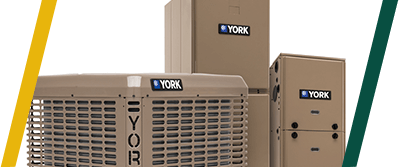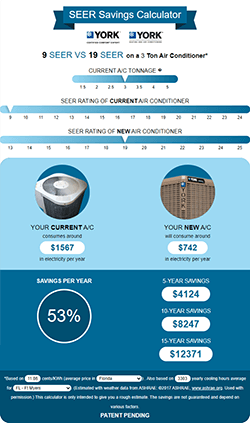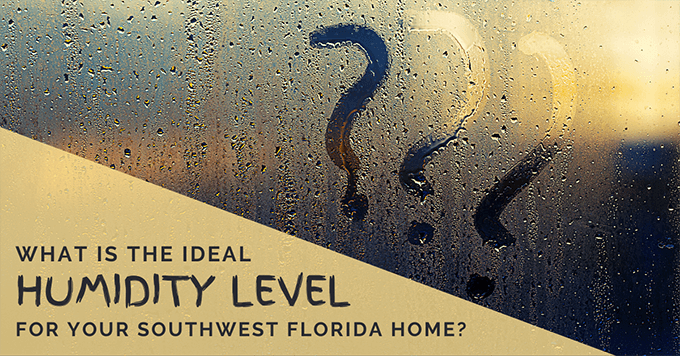
If someone asks you to describe summer weather in Florida, “humid” probably tops your list of adjectives. As a resident of Sarasota or Charlotte county or the surrounding area, you’ve surely lamented the evils of humidity. After all, humidity has a reputation for wrecking hairdos and reducing freshly showered individuals to sweaty messes within minutes of leaving the front door.
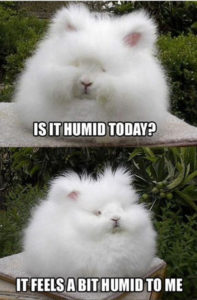
Outdoor humidity is bad enough, but when the humidity level in your home is too high, it can impact your health, and it might be a harbinger of hidden home repair needs.
So, what is the right humidity level for a home in the greater Sarasota, Florida area? Read on to find out. Plus, learn about how to identify and fix three common issues that may be causing high humidity in your home.
First, a Quick Clarification…
When we talk about humidity, we usually mean relative humidity (RH), which is expressed as a percentage. When the weather person says the relative humidity is 70%, this means that the air is holding 70% of the moisture it can contain at the current temperature. The higher the temperature, the more moisture the air is able to hold.
Ideal Relative Humidity Range
Most reliable sources agree that the ideal humidity level for an indoor environment lies between 30-60%i. The exact percentage depends on the temperature and other factors like your personal comfort preferences and whether you have allergiesii.
Now, your home air conditioner, besides cooling the air, is also responsible for removing excess moisture. Because of this, most air conditioned homes should have humidity levels within the ideal range. But if the air in your home is too humid, despite your air conditioner’s efforts, you have a problem to address.
Outside the ideal RH range, problems begin to crop up. For instance:
- High humidity makes the temperature feel hotter than it is, causing discomfort.
- You might set the AC cooler to stave off humidity even when the temperature would otherwise be tolerable. This leads to higher electricity costs.
- High RH promotes mold growth, causing damage to food and surfaces. It also triggers adverse reactions in sensitive individuals.
- Pests (such as dust mites and cockroaches) thrive in high humidity. Besides being generally unpleasant, these pests can aggravate allergies and even spread disease.
- In low humidity, skin cracks and chaps, and nasal passages dry out, which can intensify allergies or respiratory problems. Since low RH is a rare occurrence in Florida, one of the most common places you experience very low humidity is while traveling on an airplane. Here, the relative humidity levels can fall below 20%iii.
Humidity’s Impact on the Spread of Viruses
How moist or dry the air is also has an impact on the survival and spread of viruses. When the relative humidity is too low, studies showiv that virus particles remain in the air longer, allowing them to spread farther. But if the humidity is too high, viruses can survive longer on surfaces.
How Do I Monitor the Humidity Level in My Home?
You can monitor your home’s RH level by using a device called a hygrometer, or a small weather station that shows the indoor and outdoor temperature and humidity. You can find these devices at your local hardware store or online.
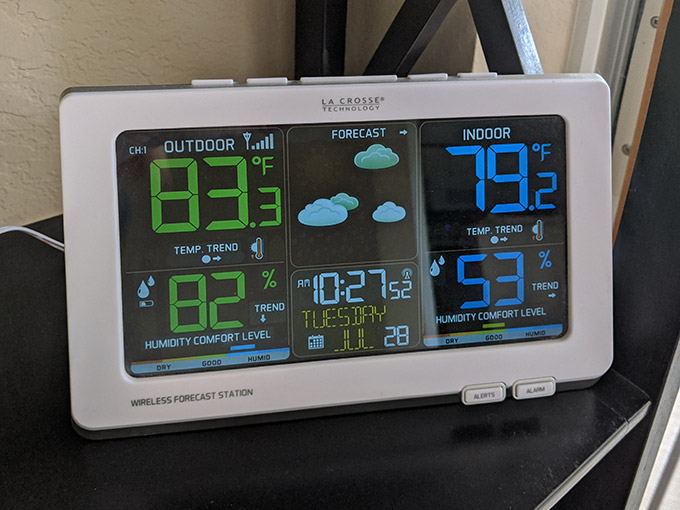
My Home’s RH is Too High. What Can I Do About This?
We recommend first identifying the cause of the high RH problem and correcting it at the source. Then, if you still want extra humidity control (e.g. in a specific area of your home), consider investing in a portable dehumidifier.
Three Common Causes of High Indoor Humidity and Their Solutions
Cause #1: Taking hot showers, cooking, or air-drying laundry indoors is adding too much moisture to the air.
How to Resolve: Ensure Proper Ventilation.
Start by running the exhaust fan when you are taking a hot shower or cooking. Exhaust fans help remove excess humidity by drawing the moist air outside, rather than allowing it to circulate in your home. In the cooler part of the day, you could even open a window for a few minutes to let the moist air out. But you’ll need to be certain that the outdoor RH is lower than your indoor RH, otherwise opening the window will have the opposite effect.
Also, if air-drying your laundry is causing humidity problems for you, use the dryer instead. As long as it’s properly vented, the dryer will channel the moisture to the outside. Because the dryer costs money in electricity, though, you’ll want to weigh the pros and cons for yourself.
Cause #2: A leak has allowed moisture to seep in where it doesn’t belong.
How to Resolve: Detect and Fix Leaks.
If you notice high humidity, signs of moisture, or a concentration of mold or mildew in a specific area of your home, you may have a leak of some kind. For instance, rainwater might be seeping in through the roof or an exterior wall, or perhaps there is a leak in your home’s plumbing. Some plumbing leaks can be seen with the naked eye, like under a sink or around a tub. Others require professional help to pinpoint their source. Contact our plumbing division, Ray’s Complete Plumbing, for help with finding and repairing plumbing leaks in your home.
Cause #3: Your air conditioner is not removing enough humidity from your home.
Your air conditioner is responsible for the lion’s share of humidity control in your home. That is, when it’s functioning as it should be. There could be several reasons why your air conditioner is not properly dehumidifying. If you suspect a problem in this area, here are a few questions to ask yourself:
Is your AC running?
Let’s start with the obvious: for the AC system to remove humidity, it must be running.
In the summer, when your air conditioner runs frequently, it should be able to remove enough humidity from your home to maintain a decent RH level.
However, during the winter months in Southwest Florida, the AC may not run for extended periods. You may still need to turn the AC on from time to time to help keep mildew at bay. Or you could use a portable dehumidifier, instead.
Is the evaporator coil dirty?
If your air conditioner’s evaporator coil (part of the air handler) is dirty, it will not be as effective at removing moisture from the air. This is part of the reason that regular AC maintenance is so important. We recommend annual (or in some cases bi-annual) air conditioner tune ups to keep your system functioning in top shape.
Is your AC the proper size for your home?
If your air conditioner is the wrong size for your home, not only will it struggle to cool properly, but it may not be able to remove humidity as effectively. An oversized air conditioner will not run long enough to lower the humidity, and an undersized air conditioner will not be able to keep up with demands for cooling and dehumidification. By size, we mean cooling capacity, which is expressed in BTU or tons. Use our BTU calculator to estimate the appropriate cooling capacity for your home. Is your unit too large or too small? The team at Kobie Complete Heating & Cooling will be happy to recommend a properly sized AC system.
About Humidistats
Some air conditioning systems are equipped with a humidistat, which maintains the RH level you set. It works by causing the air conditioner to cycle on to remove humidity, and to cycle off again when the RH level reaches the humidistat’s set point. A humidistat is not always necessary. However, if maintaining a specific humidity level is important to you, be sure to discuss your options with your AC installer.
In Summary…
Having a cool, comfortable indoor environment makes the Florida summer more bearable. By monitoring the humidity in your home and fixing common issues that affect it, you can maintain an ideal humidity level that contributes to your comfort, protects your health and preserves your home’s structure, surfaces and contents.
Call Kobie Complete Heating & Cooling for indoor air quality solutions: (941) 474-3691
Whether you’re experiencing trouble with humidity or other indoor air quality issues, Kobie Complete is here to help. Ask our team of air conditioning experts about home comfort solutions to fit your needs and budget. We serve the Southwest Florida cities of Sarasota, Venice, Englewood, North Port, Port Charlotte, Punta Gorda and the surrounding communities. Learn more about us.
Sources:
[i] EPA recommends indoor relative humidity under 60% (ideal range: 30-50%).
The CDC recommends 30-50% relative humidity.
[ii] The American Academy of Allergy Asthma & Immunology (AAAI) recommends a relative humidity level under 50% to keep dust mites at bay.
[iii] World Health Organization (WHO) Air Travel Advice
[iv] Sandoiu, Ana (April, 2020) “How humidity may affect COVID-19 outcome”, Medical News Today
Last Updated: July 29, 2023

